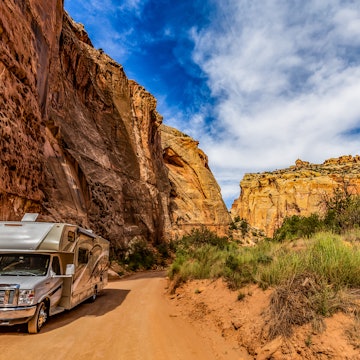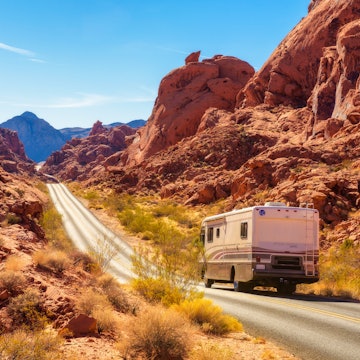

Tower Bridge and Downtown Sacramento. G3Images/Shutterstock
Set in the Central Valley just a couple of hours from the coast, Sacramento has an enviable position – there are tons of fun things to do in the city itself, and it's also a perfect base for day trips to San Francisco, Lake Tahoe and Yosemite National Park. Plan your visit to California's capital with our pick of the city's best experiences.
1. Step back in time in Old Sacramento
Looking like the set of a Western movie, Old Sacramento is a hodgepodge of Gold Rush-era buildings – some reconstructed but an impressive number are original. Old Sacramento is where the scrappy city got its start, in the mid-1800s on the heels of the discovery of gold, 45 miles away along the American River. The prospect of striking it rich enticed people from all over the world to pack up their lives and head to California.
Old Sacramento was not only a center for the new state’s government but also an important communication and transportation hub for the entire country. The cross-country Pony Express horseback mail service had its western terminus at 2nd and J streets, now commemorated with a statue of a galloping horse, and the 1869 transcontinental railroad between Sacramento and Utah connected California to the rest of the United States along Front St, where tracks and a train depot still stand.
Today, cobblestone streets and raised wooden boardwalks lead visitors around a district with some 125 restaurants, bars, cafes and shops. Pick out a new personality from Evangeline's Costume Mansion, which sells gag gifts, wigs and outfits in Sacramento’s oldest still-standing building, constructed by German immigrants using wood and brick from the ship they sailed over on in 1852. For the activity-oriented, Old Sacramento has the California State Railroad Museum, the Sacramento History Museum and escape rooms.

2. Go below the streets on an Underground Tour
On the surface, all seems normal on the streets of Old Sacramento, but the city’s original street level is actually about 10ft below where you’re standing. From Sacramento’s start, the town flooded out year after year because of its dangerous location near the confluence of the Sacramento and American rivers, until city leaders of the 1860s set about raising the “ground” level up an entire story – including all of the buildings.
You can spy the city’s original footing in the sunken brick courtyard at 2nd and I streets, but to truly dig below the surface, join an Underground Tour put on by the Sacramento History Museum, which takes you into the basements with a guide who explains just how all of the buildings were taken up a notch.
While some of the newly underground levels were used as shops and saloons, other sections were turned into outhouses and garbage dumps, revealing a fascinating insight into everyday life in early Sacramento. Don’t miss the display of cheater’s dice that were discovered in the trash heap – an unscrupulous gambler added weights into them but must have been caught or come clean.
Planning tip: Terrain is uneven so wear sturdy shoes. Arrive at least 15 minutes ahead of your booked tour time.

3. Admire art and architecture at the Crocker Art Museum
The oldest gallery west of the Mississippi, the Crocker Art Museum has an astounding assembly of work from across California, plus pieces from European masters and ceramics from around the world.
The Crocker collection spans both time – with modern works and temporary exhibitions – and space. The gallery is spread across two buildings: a huge, modern three-floor addition as well as the original space inside the Crocker home, an 1872 Italianate mansion fitting of a judge and railroad baron.
Planning tip: Make time to see the architecture of the Victorian side of the gallery, which is just as entrancing as the art on display, with painted coffered ceilings, shining parquet floors and a colorfully tiled entry.
4. Take a ride on the Sacramento River
The river that was so disastrous for 1850s Sacramento is now a tourist attraction in its own right, and you can board a boat to take in the city views.
River City Queen runs lunch and dinner cruises peppered with historical narrative and City Cruises offer a range of themed river jaunts. Beer lovers can try out Sacramento’s twist on the brew-bike theme: the Sac Brew Boat is a BYOB pedal-powered rig that crawls along the river while you “cycle” by the scenery.
Planning tip: You can bring a maximum of four drinks per person aboard the Sac Brew Boat, and no hard alcohol is allowed.

5. Get to grips with history at Sutter’s Fort
A 19th-century Swiss swindler named Johann Augustus Sutter forever changed the fate of Indigenous people and this land, at the time the Mexican province of Alta California. Sutter sparked the Gold Rush – it was during the construction of his sawmill that a shiny nugget was found, putting California firmly on the map for white European treasure seekers – and looking to build an agricultural empire, he exploited Native and Hawaiian laborers to construct a fort, the area’s first non-Native development, in 1841.
The whitewashed fort became a commercial lifeline for traders and travelers, including the famously ill-fated Donner Party. (A doll saved by an 8-year-old member of the group is sometimes on display in the fort’s small museum.) It was soon abandoned, then reconstructed in the 1890s. Today, this State Historic Park has recreated rooms showing the work carried out during the fort’s heyday. Once several miles outside the town, Sutter's Fort is now in the hip Midtown neighborhood, standing as incongruously as the Alamo in the middle of the city.
6. Learn about Sutter Fort's original inhabitants at the State Indian Museum
Just outside the tall white walls of Sutter’s Fort is the State Indian Museum, a testament to the people who have lived on this land for generations, enduring wave after wave of outsiders and the deadly diseases that came with them. Opened in 1940, the museum’s displays of intricately woven baskets, beautiful ceremonial costumes, and endearing family photos are fascinating but at times dense and dusty – plans are in the works to build a new California Indian Heritage Center in West Sacramento.
Planning tip: The gift shop, where you’ll find Native-made jewelry, dolls and carvings, frybread mix and a huge selection of books about Native people, is one of the best places in Sacramento to pick up a souvenir.

7. Eat fresh at a farm-to-fork restaurant
Thanks to its location in the Central Valley – California’s most agriculturally productive region, which grows more than half of the fruits, vegetables and nuts in the United States – Sacramento has been dubbed the nation’s “farm-to-fork” capital, and a delicious number of restaurants create plates sourced from the local bounty. The list of favorite farm-to-fork eateries is ever expanding, but mainstays include Localis, Canon, Bacon & Butter, the Waterboy, and the Kitchen.
Planning tip: September sees an entire Farm-to-Fork Festival that celebrates all flavors with live cooking events, wine tastings and an exclusive dinner on the iconic Tower Bridge, which is closed to traffic and set up with tables.
8. Sip Sacramento’s craft beer
Sacramento’s love of fresh goodies from the farm extends to its drinking scene. The wider region is home to more than 80 breweries, with a good concentration in Midtown, and a craft-brewery crawl is one of the best after-dark activities in town. Don’t miss Alaro Craft Brewery, as well known for its beers as it is for its farm-to-fork menu or Urban Roots for beers paired with barbecue. Farther afield, Oak Park Brewing Co. has a chill atmosphere and a huge patio.
9. Pedal the tracks on a rail bike
Head outdoors and into the Sacramento countryside by rail – but not on a train. In addition to beer trains, family-friendly rail routes and seasonal excursions, the River Fox Train has rail bikes, two-seater carts on the train tracks that are powered by your pedaling. Get a breath of fresh air and a unique perspective as you pedal 10 miles on this train line, which originally opened in 1911.
Planning tip: Riders must be at least 3 years old, and closed-toe shoes must be worn.
10. Cycle the American River Bike Trail
One of the best outdoor activities in Sacramento is grabbing two wheels and heading to the American River Bike Trail. Starting along the river in Old Sacramento, this 32-mile route is loved by locals, and it’s easily accessed from multiple locations along its lengthy span. On your ride, stop by the Nimbus Fish Hatchery to see whether the salmon are climbing up the fish ladders, and at Guy West Bridge, which resembles the Golden Gate Bridge in San Francisco.
















